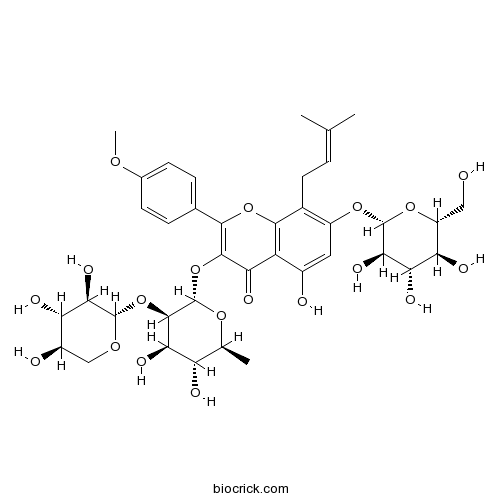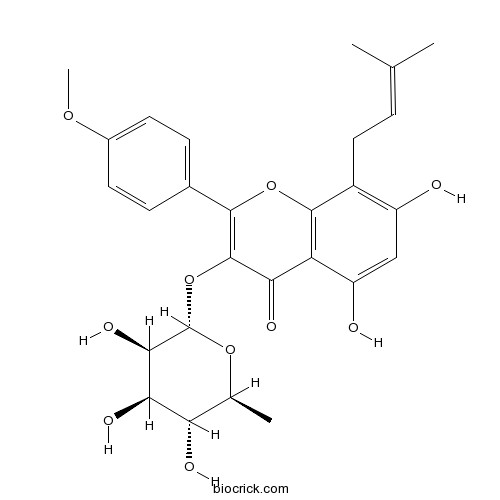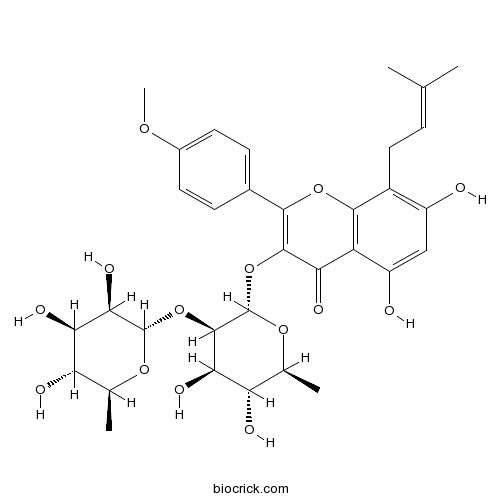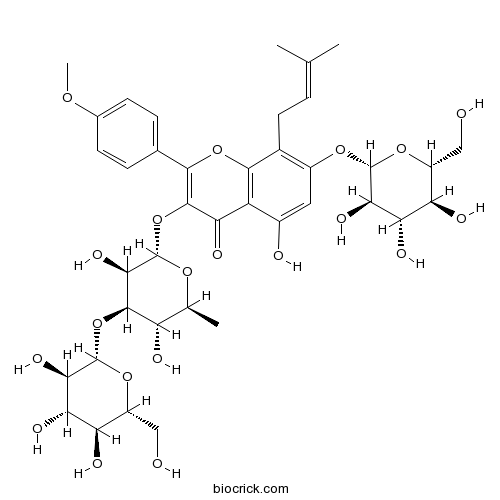Epimedium brevicornu
Epimedium brevicornu
1. The products in our compound library are selected from thousands of unique natural products; 2. It has the characteristics of diverse structure, diverse sources and wide coverage of activities; 3. Provide information on the activity of products from major journals, patents and research reports around the world, providing theoretical direction and research basis for further research and screening; 4. Free combination according to the type, source, target and disease of natural product; 5. The compound powder is placed in a covered tube and then discharged into a 10 x 10 cryostat; 6. Transport in ice pack or dry ice pack. Please store it at -20 °C as soon as possible after receiving the product, and use it as soon as possible after opening.

Natural products/compounds from Epimedium brevicornu
- Cat.No. Product Name CAS Number COA
-
BCN1038
Epimedin A110623-72-8
Instructions

-
BCN1039
Epimedin B110623-73-9
Instructions

-
BCN1040
Epimedin C110642-44-9
Instructions

-
BCN5350
Baohuoside I113558-15-9
Instructions

-
BCN5352
Icaritin118525-40-9
Instructions

-
BCN2887
Baohuoside V118544-18-6
Instructions

-
BCN2889
Baohuoside VII119730-89-1
Instructions

-
BCN3464
2''-O-Rhamnosylicariside II135293-13-9
Instructions

-
BCN5935
Epimedin A1140147-77-9
Instructions

-
BCN2886
Epimedoside A39012-04-9
Instructions

-
BCN5570
Hyperoside482-36-0
Instructions

-
BCN5926
Ononin486-62-4
Instructions

-
BCN6311
Icariin489-32-7
Instructions

-
BCN2888
Baohuoside II55395-07-8
Instructions

-
BCN8471
Inositol87-89-8
Instructions

Effects of water extract from epimedium on neuropeptide signaling in an ovariectomized osteoporosis rat model.[Pubmed: 29705515]
For the past millennium, water extract from Epimedium (dried leaves of Epimedium brevicornu Maxim.) has been widely used for bone disease therapy in traditional Chinese medicine and has been reported to exhibit salutary effects on osteoporosis in clinical trials. The therapeutic effect of Epimedium is associated with the function of the brain in traditional Chinese medicine theory.
Anti-Inflammatory Activity of Epimedium brevicornu Maxim Ethanol Extract.[Pubmed: 29620952]
None
[Study on original investigation, macroscopic and microscopic identification of pharmacopoeia contained species of Epmedii Folium].[Pubmed: 29600643]
Epimedii Folium is a commonly used traditional Chinese drug, and now still depends on the wild resource. In recent years, with the surge in consumption, the resources are declining, the use of market varieties are constantly changing. In this paper, Production and sales situation of the five species contained in pharmacopoeia(Epimedium brevicornu, E. sagittatum, E. pubescens, E. koreanum and E. wushanense) have been studied on the basis of the existing researches, in-depth investigation and collection of accurate plant specimens and samples. And the origins of Epimedii Folium regulated by the pharmacopoeia have been discussed. At the same time, more exclusive and practical features have been summarized on the basis of observation and comparison with the stereo, optical and stereo-fluorescence microscopy technologies, and refering the related literatures on leaf structure and anatomy.The results of this study will provide a useful reference for the clinical medication, supervision, inspection, and standard drafting and so on.
Simultaneous Preparation and Comparison of the Osteogenic Effects of Epimedins A - C and Icariin from Epimedium brevicornu.[Pubmed: 29451707]
In this study, epimedins A-, B-, and C-, and icariin-rich extracts were simultaneously isolated from Epimedium brevicornu Maxim. through a convenient four-stage process consisting of solvent extraction, macroporous resin column pre-concentration, extraction fractionation, and reversed-phase (RP) silica gel column chromatography. Single factor experiments and response surface methodology (RSM) were used to optimize the preparation conditions. In the final products, the purities of epimedins A - C and icariin were 23.04%, 64.50%, 54.92%, and 77.54%, respectively, which will lay a foundation for the further purification of epimedin monomers and full utilization of Epimedium resources. Meanwhile, the osteogenic effects of epimedins A - C were investigated for the first time and compared with that of icariin, which will provide guidance for the clinical applications of Epimedium in the treatment of osteoporosis.
Prenylated flavonoids and dihydrophenanthrenes from the leaves of Epimedium brevicornu and their cytotoxicity against HepG2 cells.[Pubmed: 29172686]
None
Contents of Heavy Metals in Chinese Edible Herbs: Evidence from a Case Study of Epimedii Folium.[Pubmed: 28620728]
Toxic heavy metal contamination in Chinese edible herbs has raised a worldwide concern. In this study, heavy metals in Epimedii Folium, an edible medicinal plant in China, were quantitatively analyzed. Variations of heavy metals in different species, in various organs (i.e., leaves, stems, and roots), in wild-growing and cultivated plants, and in 35 market samples of Epimedii Folium, were systematically investigated. In all of Epimedium samples, Hg (mercury) was not detectable (0.00 μg/g). Four species, Epimedium pubescens, Epimedium sagittatum, Epimedium brevicornu, and Epimedium wushanense, were found to contain Cu (copper) and Pb (lead). And contents of Cu and Pb in E. brevicornu were significantly higher than those in other species (P < 0.01). In wild-growing and cultivated Epimedium plants, Cd (cadmium) and As (arsenic) were not detectable, and concentrations of Cu and Pb in wild-growing plants were significantly higher than those in cultivated plants (P < 0.01). Cd was not detectable in leaves, roots, and stems, while organ specificity was apparent in the distribution of Cu, As, and Pb. And the highest levels of Cu and Pb were observed in roots and leaves, respectively. In Chinese markets, several samples of Epimedii Folium contained excessive Cu, Cd, As, and Pb beyond the national permissible limits. In summary, there was a large variation of heavy metals among Epimedii Folium samples, and Cu and Pb were the most important heavy metals contaminating the edible medicinal plant. Application of Epimedii Folium to drug and food industries will need to focus more on toxic heavy metal contamination.
Metabolism profiles of icariin in rats using ultra-high performance liquid chromatography coupled with quadrupole time-of-flight tandem mass spectrometry and in vitro enzymatic study.[Pubmed: 27620672]
Icariin (ICA), the major constituent of Epimedium brevicornu Maxim, is recognized as an effective agent for the treatment of osteoporosis. In our previous report, the relatively short half-life (74min) and poor bioavailability (approximately 0.1%) of ICA in rats suggested that not only ICA itself but also its metabolites could be responsible for the observed osteoporosis treatment effect. Therefore, the present study aimed at identifying the metabolites of ICA in rat plasma, bile, urine, and feces after the administration of a single oral dose of ICA (150mg/kg). In this work, ultra-high performance liquid chromatography coupled with electrospray ionization quadrupole time-of-flight tandem mass spectrometry (UHPLC/Q-TOF-MS) method was established to identify the metabolic profiles following intragastric administration of pure ICA in rats. The blood, bile, urine, and feces samples of the rats were investigated to explore the complete metabolic pathway of ICA in vivo. A total of 14 metabolites were detected in the bile, revealing that the bile is the main excretion pathway for ICA and its metabolites. The conjugated metabolites as observed in vivo, was further confirmed by the in vitro enzymatic study. Five metabolites of ICA, including demethylicariin, icariside I-3-O-glucuronide, demethylicariside II, demethylicariside II-7-O-glucuronide, and dehydroxyicaritin-glucuronide, were reported for the first time in the literature. In addition, the results revealed that the principal metabolism pathways of ICA in rat were deglycosylation and glucuronidation after deglycosylation.
Comparative proteomic and metabolomic analysis reveal the antiosteoporotic molecular mechanism of icariin from Epimedium brevicornu maxim.[Pubmed: 27422162]
Icariin, a principal flavonoid glycoside of Epimedium brevicornu Maxim, has been widely proved to possess antiosteoporotic activity with promoting bone formation and decreasing bone resorption. However, the involving mechanisms remain unclear.


